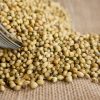Where animal protein is a luxury, particularly in Asia, many cooks use a small amount, just enough to give flavor to a dish with an abundance of vegetables, noodles, or rice. At a Thai restaurant, try a classic Pad Thai, made mainly of vegetables like bean sprouts and scallions, bean curd, rice noodles, a small amount of meat and the generous seasoning of cilantro leaves, peanuts and a tangy sauce. A Japanese nabemono, or communal one-pot meal, contains a small amount of meat or fish and a large portion of a variety of vegetables, with small bowls of rice to accompany it. Even eggs are stretched in Asian cooking, as in Chinese Egg Foo Yong.
Apart from the fact that health experts say most Americans eat more animal protein than their bodies need, there are many reasons to eat less. Eating less meat reduces the amounts of fat and cholesterol consumed, which reduces the risk of serious chronic diseases like cancer and diabetes. It is also easier on the budget and the environment, too.
Eating less meat does not have to mean eating it less often. It simply means serving smaller portions. The American Institute for Cancer Research recommends a three-ounce portion of cooked meat, poultry, or fish, which usually means starting with a four-ounce uncooked piece that loses an ounce in cooking. Served in one piece, this may seem modest compared to whopping burgers, foot-long hot dogs, or a half a broiled chicken. But this makes more room on the plate for whole grains, beans and vegetables � all of which offer health protection. An alternative is to cut up the meat into bite-size pieces, as done in Asia and other parts of the world, and mix it into a melange of vegetables and grain-based foods.
This Egg Foo Yong is made with shrimp and broccoli, plus a combination of eggs and flour that holds everything together. It is made in a non-stick skillet rather than a wok, without using oil, and topped with a savory, thick, brown sauce, just as it is at my favorite Chinese restaurant.
Asian Frittata with Shrimp and Broccoli
Makes 4 servings.
Ingredients
- 2 cups broccoli florets, cut in 1/2-inch pieces
- 2-3 scallions, finely chopped
- 1 medium red onion, finely chopped (1 cup)
- 1 cup fresh bean sprouts
- 1-1/2 cups peeled, cooked shrimp, cut in 1/2- inch pieces (about one-third pound)
- 1/4 tsp. roasted sesame oil
- 5 large eggs
- 2 Tbsp. all-purpose flour
- 1/4 tsp. freshly ground pepper
- 1 Tbsp. corn starch
- 1 Tbsp. cold water
- 1 Tbsp. reduced sodium soy sauce
- 1 tsp. rice vinegar
- 1 small garlic clove, minced
- 1/2 tsp. grated or minced ginger
- 1/2 tsp. sugar
Directions
- Combine broccoli, scallions, onion, bean sprouts, shrimp, sesame oil and pepper in a bowl. Whisk eggs and flour in another bowl until lumps are almost gone, about 2 minutes. Pour over the vegetable mixture, mixing well with a fork. Set aside. Preheat broiler.
- In a small bowl, mix cornstarch into water to dissolve and place near the stove. In a small pan, bring soy sauce, vinegar, garlic, ginger, sugar and broth to a boil over medium heat. Re-stir cornstarch mixture and whisk in until mixture is thick and clear, about 1 minute. Remove from heat. Set aside.
- Coat a large, oven-proof, non-stick skillet with cooking spray. Heat pan over medium-high heat. Re-stir egg-vegetable mixture and pour in, smoothing it into an even layer. When eggs are set and the bottom is browned, about 4 minutes, place the pan under the broiler until the top is browned and the center almost dry, about 2 minutes.
- Loosen the frittata with a metal spatula. Slide it onto a serving plate. Cut into wedges and serve with warm sauce.
Nutritional Info Per Serving:
188 calories,
7 g. total fat (2 g. saturated fat),
13 g. carbohydrate,
19 g. protein,
2 g. dietary fiber,
329 mg. sodium
Diabetic Exchanges: 2-1/2 Medium-Fat Mea, 2-1/2 Vegetablet
AICR










